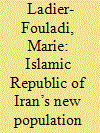| Srl | Item |
| 1 |
ID:
155797


|
|
|
|
|
| Summary/Abstract |
This study aimed to examine the relationship between maternal health and good quality of life in an attempt to understand the years between 2005 and 2011. Data from the Ethiopia Demographic and Health Surveys 2005 and 2011 were used. Bivariate, Camer-V, chi-square and logistic regression analyses were used to determine the relative contribution of the predictor variables. The hypotheses tested in this study were that gender, wealth quintile, type of place of residence and region are highly significant with women’s education and work status. Females’ expected age (adjusted odds ratio = AOR) for some school training has dropped in 2011 from 0.678 to 0.255 for the age group 25–34, but male expected age (AOR) for some school has increased in 2011 from 0.784 to 2.274. The age of the respondent, age at first cohabitation and socio-economic variables were positively associated with having visited health facilities in the last 12 months and being visited by a family planning worker.
|
|
|
|
|
|
|
|
|
|
|
|
|
|
|
|
| 2 |
ID:
180029


|
|
|
|
|
| Summary/Abstract |
After dropping rapidly and steadily over two decades, fertility in Iran stabilized between 2001 and 2011 at around 1.9 to 2 children per woman, before starting to rise slightly between 2012 and 2016, then falling fairly quickly. This coincided with the implementation of the Islamic Republic’s new population policy, with its aggressive and coercive measures, one of whose goals was to reverse the downwards trend in fertility. Given changes in proximate and remote determinants of fertility in Iran, and the decline in fertility since 2016, it is assumed that this new population policy triggered a reduction in intervals between births between 2012 and 2015, leading to a slight rise in the fertility of already married couples. The other latent objective of the Islamic Republic’s new population policy is to drive Iran’s population up to 150 million inhabitants in the near future. This is utopian given Iran’s demographic dynamics, but it conceals the political and ideological goal of asserting Iran’s demographic and geopolitical significance within the region, by drawing on a novel immigration policy to make up for its low fertility.
|
|
|
|
|
|
|
|
|
|
|
|
|
|
|
|